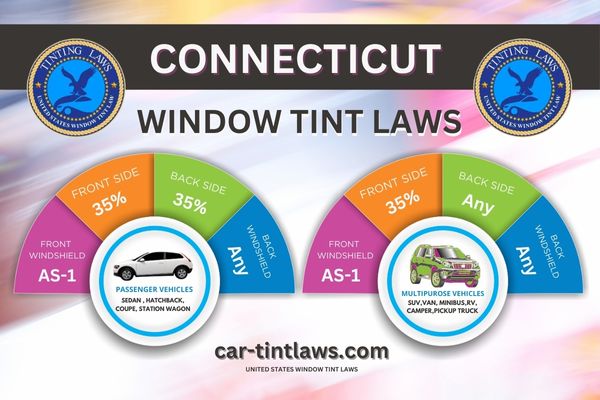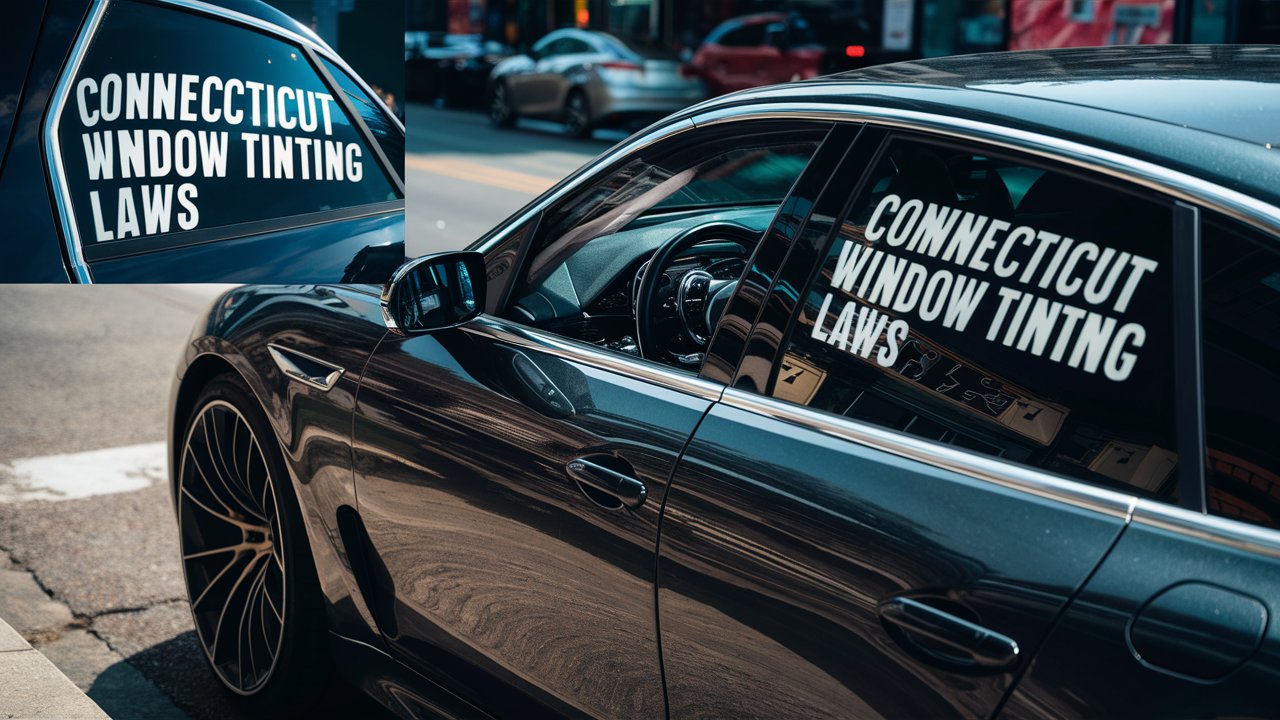When it comes to window tinting in Connecticut, do you really know the rules?
You might think you can just pick any tint you like, but the state’s laws are quite specific.
For instance, sedans can only have non-reflective tint on the top 6 inches of the windshield, while SUVs and vans have slightly different regulations.
You’ll need to make sure that your tint film is certified by the manufacturer, and don’t forget the compliance sticker.
But what happens if you don’t abide by the rules? The consequences could be more severe than you imagine.
Window Tint Darkness in Connecticut
You’ll find that Connecticut has specific requirements for window tint darkness, with different rules for sedans, SUVs, and vans.
For sedans, the law dictates the Visible Light Transmission (VLT) percentages for the windshield, front side, back side, and rear windows.
Similarly, SUVs and vans have their own VLT percentages that must be followed, so it’s essential to understand these distinctions to guarantee compliance.
Tint darkness for sedans:
- Windshield: Non-reflective tint is allowed on the top 6 inches of the windshield.
- Front Side windows: Must allow more than 35% of light in.
- Back Side windows: Must allow more than 35% of light in.
- Rear Window: Any darkness of tint is allowed.
Tint darkness for SUV and Vans:
- Windshield: Non-reflective tint is allowed on the top portion of the windshield, above the AS-1 line.
- Front Side windows: Must allow more than 35% of light in.
- Back Side windows: Any shade can be used.
- Rear window: Any shade can be used.
Window Tint Reflection in Connecticut
In Connecticut, window tint reflection rules differ for sedans, SUVs, and vans. For sedans, the state regulates both front side and back side window reflection to control glare and heat.
Similarly, SUVs and vans have specific limits on how much light can be reflected from their front side and back side windows, ensuring compliance with state laws.
Tint reflection for sedans:
- Front Side windows: Must not exceed 21% reflective shading.
- Back Side windows: Must not exceed 27% reflective shading.
Tint reflection for SUV and vans:
- Front Side windows: Must not be more than a certain level of reflectivity.
- Back Side windows: Must not exceed the allowed reflection limits.
Other Connecticut window tint rules and regulations
- Side Mirrors: No restrictions.
- Restricted Colors: In Connecticut, all tint colors are permitted.
- Certificates: Manufacturers of film need to certify the film they sell in the state. Ask your dealer if they are using certified film.
- Stickers: The sticker/label of compliance to identify legal tinting is required between the film & glass on each tinted window.
- Medical Exceptions: Connecticut permits medical exemptions for special tint. For more details about the specific terms of the exemption, consult CT state law.
- Penalties: Connecticut enforces penalties for illegal tint, with fines for non-compliance.

Medical Exemptions for Window Tint Rules in Connecticut
Individuals with specific medical conditions, such as Lupus and Porphyria, can secure medical exemptions to legally tint their car windows in Connecticut.
These medical exemptions allow them to protect their health while following the state’s window tint rules.
To qualify for a medical exemption, you’ll need to have a licensed physician complete Form E-220, certifying that your medical condition requires window tinting.
Once your form is complete, the Commercial Vehicle Safety Division must validate the exemption.
Under this exemption, you’re allowed to have window tint with a darkness down to 20% Visible Light Transmission (VLT).
This is essential for those who need to minimize exposure to harmful UV rays due to their medical conditions.
However, it’s important to make sure that your tint does not fall below the 20% VLT threshold. Failure to comply with tint regulations could result in a referral to the Medical Review Unit, which could complicate your exemption status.
Understanding the process and requirements for medical exemptions is vital for legally tinting your car windows in Connecticut, ensuring you stay within the confines of the law while safeguarding your health.
Connecticut Application & Special Permit for Exemption from Tinted Window Requirements
Connecticut Window Tint Ticket Cost
If you’re caught with illegal window tint in Connecticut, you could be facing a $150 ticket.
The Connecticut window tint ticket cost is a flat rate fine aimed at ensuring compliance with state regulations.
When you’re issued a ticket for illegal tint violations, you have 60 days to remove the non-compliant tint from your vehicle.
Failing to address the issue within this timeframe can lead to more severe consequences, including car impoundment.
The purpose of the $150 fine is to penalize non-compliance and encourage vehicle owners to adhere to the legal standards for window tinting.
Strict adherence to these regulations is vital not only to avoid fines but also to prevent the potential impoundment of your car.
Understanding and following the laws helps maintain safety and legality on the road, fostering a sense of responsibility and community among Connecticut drivers.
Connecticut Vehicle Registration Details
When registering your vehicle in Connecticut, you need to make sure it has valid registration, which must be renewed annually.
The necessary documentation includes vehicle information, owner details, and the registration’s expiration date.
You can renew your registration online, in person, or by mail through the DMV, making sure you avoid fines or penalties for late renewal.
Registration Requirements
To legally drive in Connecticut, you must register your vehicle with the Department of Motor Vehicles (DMV) and meet all specified requirements.
This includes adhering to window tint laws, ensuring your vehicle registration is current, and displaying valid registration stickers on your vehicle.
Vehicle registration in Connecticut involves providing proof of ownership and insurance, along with passing a vehicle emissions test if applicable.
Your vehicle registration must be renewed annually, a process that typically requires payment of registration fees.
It’s important to renew your registration on time to avoid fines or penalties.
The DMV will issue registration stickers, which must be visibly displayed on your vehicle as proof of current registration.
Failure to register your vehicle or renew its registration on time can lead to legal consequences, including fines and penalties.
Ensuring your vehicle is properly registered not only keeps you in compliance with state laws but also helps you feel part of the community of responsible drivers.
By staying informed about window tint laws and maintaining up-to-date vehicle registration, you contribute to safer and more regulated roadways in Connecticut.
Necessary Documentation
For proper vehicle registration in Connecticut, you’ll need to provide essential documentation that verifies ownership and complies with state regulations.
This documentation includes specific details about your vehicle, such as make, model, year, and VIN number.
Accurate and up-to-date vehicle registration is vital, especially when adhering to Connecticut window tinting laws.
Confirming your registration information matches the vehicle being tinted is necessary for legal compliance and avoiding potential issues.
When you bring your vehicle in for window tinting, having accurate registration details on hand is important.
This is because Connecticut window tint regulations require that your vehicle’s information be verified to guarantee proper application and adherence to the law.
If you’re seeking a medical exemption for window tinting, your registration documents will also be necessary to process the exemption request.
Maintaining current and precise vehicle registration not only guarantees compliance with Connecticut window tinting laws but also helps you avoid legal complications.
Your registration records should always reflect your vehicle’s correct information to support any tinting modifications you plan to make.
Proper documentation fosters a sense of belonging within the community of responsible vehicle owners, all following state regulations.
Renewal Process
Renewing your vehicle registration in Connecticut is a simple process that typically happens annually.
The Connecticut Department of Motor Vehicles (DMV) sends out renewal notices to remind you when it’s time to update.
These notifications will outline the necessary steps and any specific requirements you need to meet, such as emissions testing and payment of registration fees.
One convenient feature is the availability of online renewal options. This allows you to complete the update process from the comfort of your home, avoiding the need to visit a DMV office in person.
Not only does this save time, but it also streamlines the process considerably.
When it comes to ensuring your vehicle complies with state regulations, remember to check Connecticut’s window tint laws during your renewal.
Non-compliance can result in fines or penalties, which might complicate your update process.
Failing to update your registration on time can lead to fines and additional penalties. To avoid these, make sure to follow the instructions in your renewal notice and take advantage of the online renewal options if available. Staying informed and proactive guarantees a smooth renewal experience each year.
References
General Statutes of Connecticut, Title 13b, Chapter 246, Section 14-99g
Quick Reference on Tinted Windows (Connecticut DMV)
Frequently Asked Questions
What Is the Darkest Legal Tint in Ct?
You’re wondering about the darkest legal tint in CT, right? For sedans, it’s 35% VLT. There are exceptions for SUVs and vans. Keep safety concerns in mind; tint laws balance benefits and drawbacks of tinting.
Can You Get Pulled Over in CT for Tints?
Absolutely, you can get pulled over in CT for tints! Ignoring tint laws can lead to unimaginable tinted windows consequences, despite the benefits. Don’t fall for tinted windows myths; compliance keeps you safe and ticket-free.
Can You Pass an Inspection With Tinted Windows Ct?
You can’t pass an inspection in CT if your tinted windows don’t meet inspection requirements. Make sure your tint complies with tinted windows limitations to avoid legal consequences and feel confident knowing your vehicle’s within the law.
How to Get a Tint Exemption in Ct?
To get a tint exemption in CT, you’ll need a physician’s certification for specific medical conditions. Complete Form E-220 for the tint exemption process, ensuring your vehicle modifications follow the state’s VLT percentages.
Conclusion
Deciphering Connecticut’s window tinting laws can feel like unraveling an ancient code, but it’s vital for legal compliance and safety. Confirm your sedan or SUV meets the VLT and reflection standards, and showcase the mandatory certification and compliance stickers. If you have a medical exemption, keep the essential documentation handy. Failing to comply with these regulations could lead to fines or even vehicle impoundment. Stay informed and abide by the rules to evade these penalties.
